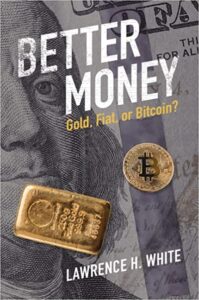In Search of Stable Money
By Arnold Kling


- Under a gold standard, government bonds are nearly free of inflation risk but not of default risk. Under a fiat standard, the reverse is true.
- ——White, Lawrence H. Better Money: Gold Fiat or Bitcoin? (pp. 214-215).1
It would seem that the best monetary standard is one in which the purchasing power of the monetary unit is stable. An unreliable money imposes large costs on households and businesses. They have to spend resources understanding the meaning of price movements (is this a relative price change or part of general inflation?), forecasting the rate of inflation, and trying to protect purchasing power of savings.
The search for the best monetary standard is therefore a search for stable money. White analyzes gold, fiat money, and Bitcoin from that perspective.
A gold standard is one in which a dollar is defined as a certain weight of gold. This means that all dollar exchanges can be ultimately settled in gold. But it does not mean that all payments must be made in gold.
Suppose that all of the gold in the world sits in a single vault. Title to the gold is tracked on a computer. What circulates are abstract representations of title to gold. These could be dollar bills, bank checks, or other media. When I pay for groceries, the amount of gold to which I have title goes down, and the amount to which the grocer has title goes up.
White points out that one reason that banking emerged is that payment using physical gold was cumbersome. Coins were not uniform:
- Out of the coin-changing business, modern banking arose to provide a way for merchants to cope with the confusing welter of coins. p. 51
A bank can over-issue notes. It can profit by lending out more than the value of its reserves (which would be gold under a gold standard). The bank is counting on not all depositors redeeming their notes at once. This is called fractional-reserve banking. If fractional-reserve banking were outlawed, then profitable opportunities to the economy would be lost. But if banks do over-issue, they are potentially subject to runs. White suggests that some fractional-reserve banking is natural, and I agree that its advantages outweigh its pitfalls. However, these advantages and pitfalls prevail under any monetary standard.
In a fiat money standard, the government issues money, and people accept money as payment. As White points out:
- No country we know of switched to a fiat standard following an open public discussion of its benefits and costs. p. 194
Instead, fiat currency arises from a bait-and-switch. A government will start with a well-defined currency, with its value tied to gold or some established foreign currency. Then the public becomes accustomed to using that currency. At some point—typically during a crisis—the government will let the currency float, dropping its promise to exchange currency for gold or other valuable assets. Europeans switched to fiat currencies during World War I in order to be able to print more money to pay for the war. America did it in 1971, because it could no longer sustain redeeming paper dollars for gold at the parity established at Bretton Woods in 1944.
Network effects and lock-in effects enable the bait-and-switch to fiat currency. The network effect is that when other people are using a medium as money, it pays for me to accept that medium as money. Because other people are using it, I know that I will be able to use it. In this way, people are, to a large extent, locked in to using currency even after the government withdraws its promise to maintain the value of the currency. Network and lock-in effects:
- … habituate people to accept redeemable paper money, with the result that, when redemption ends, they continue accepting it so long as it works, and it works (given moderate supply growth) so long as others follow the same strategy. (p. 195)
This means that a society is not necessarily using the optimal money. There might be a better monetary standard available, but no one will switch because they are waiting for others to switch.
An argument against fiat money is that it makes it tempting for governments to run deficits, print money, and inflate away its debts. An argument for fiat money is that it gives the government more freedom to engage in counter-cyclical fiscal and monetary policy, creating better macroeconomic stability.
White argues that in practice, fiat money has made macroeconomic instability worse, not better. He compares macroeconomic performance in the United States in three eras: prior to the establishment of the Federal Reserve in 1913; under a Fed-managed gold standard from 1913 to 1971; and under pure fiat money standard from 1971 to present. He indicts the fiat money regime as having high inflation and volatility, particularly compared with the gold standard as it operated prior to 1913.
A large section of Better Money discusses a Bitcoin standard. White argues that in theory Bitcoin could offer the benefits of a gold standard, but because of network and lock-in effects it will be difficult for the economy to shift to a Bitcoin standard.
One issue with Bitcoin is that some people want to use Bitcoin through intermediaries for convenience and efficiency, but other people want to avoid intermediaries in order to preserve privacy. These two different modes of use do not reinforce one another. They do not create a single network effect for Bitcoin.
Under our existing fiat currency regime, gold and Bitcoin are speculative assets. One motivation for speculating in gold or Bitcoin is to protect against a complete collapse of the fiat dollar. If government deficits continue to be mismanaged, it could transpire that hyperinflation breaks out, driving the value of the dollar to zero. In this (unlikely) event, Bitcoin and/or gold would be very valuable.
The dollar prices of gold and Bitcoin are volatile, but White points out that this actually represents uncertainty about the value of the fiat dollar. If the fiat dollar were certain to remain stable, then speculative demand for gold and Bitcoin would disappear. On the other hand, if gold were adopted as a monetary standard (a dollar = x ounces of gold), that also would eliminate speculative demand. Under a gold standard, the purchasing power of gold would be stable. It is unstable today because we are in a fiat money standard that seems fragile.
White notes that Bitcoin’s price is more volatile than the price of gold. He repeatedly blames this on the fact that Bitcoin’s supply is inelastic: it is fixed by an algorithm and cannot respond to price changes.
I did not find this argument persuasive. Gold supply is highly inelastic, also. That is because the stock of gold is large relative to what can be extracted from mines or jewelry in a year. Indeed, a highly variable supply is not desirable for a monetary standard.
For more on these topics, see
- Gold Standard, by Michael D. Bordo. Concise Encyclopedia of Economics.
- Competing Money Supplies, by Lawrence H. White. Concise Encyclopedia of Economics.
- “Can Cryptocurrencies Become Money?” by Nicolas Cachanosky. Library of Economics and Liberty, Nov. 1, 2021.
 Lawrence H. White on Monetary Constitutions. EconTalk.
Lawrence H. White on Monetary Constitutions. EconTalk.
I think that Bitcoin’s price is more volatile than gold because its speculative demand is more volatile. The participants in Bitcoin speculation are relatively few in number, so that the market is thinner. Third-party exchanges are much less well established. Speculators have little historical experience to go on, so that their expectations can change suddenly. Bitcoin’s potential to serve as a store of value in case of a fiat money collapse are much less certain than the potential for gold.
- Better Money: Gold, Fiat, or Bitcoin, 6/15/23. YouTube.
As an individual, I find the present situation regarding fiat money to be challenging and disturbing. I am one of those who view present fiscal policy in the United States to be on an unsustainable course. To me, it looks as though at least some significant inflation is inevitable. To speculate in gold or Bitcoin, I would have to be confident that my outlook for inflation is higher than that of other speculators in those assets. If their outlook for inflation is more dire than mine, then they have already bid prices above the “right” level. So my own search for a stable source of value in an environment of fiscal recklessness is a never-ending challenge.
*Arnold Kling has a Ph.D. in economics from the Massachusetts Institute of Technology. He is the author of several books, including Crisis of Abundance: Rethinking How We Pay for Health Care; Invisible Wealth: The Hidden Story of How Markets Work; Unchecked and Unbalanced: How the Discrepancy Between Knowledge and Power Caused the Financial Crisis and Threatens Democracy; and Specialization and Trade: A Re-introduction to Economics. He contributed to EconLog from January 2003 through August 2012.
Read more of what Arnold Kling’s been reading. For more book reviews and articles by Arnold Kling, see the Archive.
